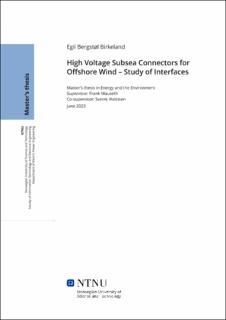| dc.contributor.advisor | Mauseth, Frank | |
| dc.contributor.advisor | Hvidsten, Sverre | |
| dc.contributor.author | Birkeland, Egil Bergstøl | |
| dc.date.accessioned | 2023-09-19T17:20:02Z | |
| dc.date.available | 2023-09-19T17:20:02Z | |
| dc.date.issued | 2023 | |
| dc.identifier | no.ntnu:inspera:146046472:58399494 | |
| dc.identifier.uri | https://hdl.handle.net/11250/3090580 | |
| dc.description.abstract | Europakommisjonen har satt som mål å nå 450 GW med offshore vindparker innen 2050, og med det bli det første karbonnøytrale kontinentet. Det er nødvendig å utvikle teknologi for å redusere kostnaden av flytende vindparker langt fra land. En viktig komponent hvor det trengs utvikling er høyspent koblere med spenningsnivå på 245 kV. En kritisk del av designet vil være grensesnittet mellom elektroden og isolasjonsmaterialet.
Grensesnittet kan bli undersøkt ved å støpe isolasjonskopper rundt aluminiumsdisker. Aluminiumsdiskene vil fungere som elektroder som har gjennomgått ulike overflatebehandlinger. Overflatebehandlingene som har blitt brukt i denne oppgaven er sandblåsing med to ulike partikkeltyper og polering kombinert med varm AC anodisering. Alle testobjektene ble støpt med støpeprosedyren som ble funnet i spesialiseringsprosjektet.
De ferdiglagde isolasjonskoppene ble tatt videre til et testoppsett, som er designet for å måle partielle utladninger og gjennomslagstester. Tennspenningen og slukkespenningen for de partielle utladningene ble funnet ved å justere spenningen opp 1 kV annet hvert minutt helt til utladninger var synlige og så redusere med 1 kV i samme tidsintervall til utladningene forsvant. Videre ble størrelsen på utladningene undersøkt for å undersøke veksten av elektriske trær. Til slutt ble det gjennomført gjennomslagstester på koppene med tilfredsstillende kvalitet.
Resultatene fra profilometeret viste at diskene med samme overflatebehandling hadde relativt like overflateparametre, som legger til rette for nøyaktige sammenligninger mellom overflatebehandlingene. Elektrodeoverflatene som ble sandblåst med aluminiumsoksid(0.5-1.0 mm) og glasskuler(0.25-0.42 mm) ga gjennomsnittlige S_a-verdier på henholdsvis 11.5 μm og 4.3 μm. Elektrodeoverflatene som ble polerte og varm AC anodisert hadde en gjennomsnittlig S_a-verdi på 54 nm.
Påvirkningen av overflateruheten på fordelingen av elektrisk felt ble analysert ved hjelp av 2D simuleringer i COMSOL. Simuleringene viste at en økning i overflateruheten førte til en økning i feltforsterkning, spesielt i toppene på overflaten. Resultatene fra simuleringene ble bekreftet av resultatene fra laboratorietestingen. Tennspenningen hadde ikke noen betraktelig forskjell, men det gjennomsnittlige elektriske feltet for initiering av elektriske trær ble 14 kV/mm, 17 kV/mm og 21 kV/mm fra grovest til glattest overflate. Videre ga testobjektene med polerte og varm AC anodiserte elektrodeoverflater den høyeste holdfastheten med 38 kV/mm, mens den groveste elektrodeoverflaten hadde en holdfasthet på 26 kV/mm.
Alle funnene i avhandlingen bekreftet at overflateruheten vil påvirke isolasjonsytelsen. En økning av overflateruheten vil føre til høyere feltforsterkning som vil bidra til å redusere det elektriske feltet hvor elektriske trær er initiert og hvor utladninger kommer over 1 nC, samt redusere holdfastheten. Derfor kan det konkluderes med at en økning i overflateruhet vil redusere isolasjonsytelsen. | |
| dc.description.abstract | The European Commission has set a goal to have 450 GW of offshore wind farms by 2050, and by that become the first carbon-neutral continent. It is vital to develop technology to reduce the price of floating wind farms located far from shore. An important component that needs development is dry-mate 245 kV connectors. A critical part of the design of such connectors is the interface between the electrode and the insulation material.
The interface can be examined by casting insulation cups around aluminium discs with known surface roughness parameters. The aluminium discs will function as electrodes that have undergone different kinds of surface preparation methods. The applied surface preparation methods in the thesis are sandblasting with two different particle types and polishing combined with hot AC anodising. All the test objects were cast with the casting procedure that was deemed best in the specialisation project.
The finalised insulation cups were taken into a test setup, designed for PD measurements and breakdown tests. PDIV and PDEV were found by increasing the voltage by 1 kV every two minutes until there were visible discharges and then decreasing by 1 kV in the same time interval until the discharges disappeared. Furthermore, the discharge magnitudes were used to examine electrical tree initiation and growth. Lastly, breakdown tests were conducted for the test objects without defects.
The profilometry results from the discs showed that the aluminium discs had relatively equal surface roughness within the surface preparation methods, which provided a foundation for an accurate comparison of the impact of surface roughness. The electrode surfaces sandblasted with aluminium oxide(0.5-1.0 mm) and glass orbs(0.25-0.42 mm) gave average S_a-values of 11.5 μm and 4.3 μm respectively. The electrode surfaces that were polished and hot AC anodised had an average S_a-value of 54 nm.
The impact of the surface roughness on electric field distribution was analysed with 2D simulations in COMSOL. The simulations showed that increasing the surface roughness increased the field enhancement, especially at the surface peaks. The results from the simulations were corroborated with the results from the laboratory testing. There was not a considerable difference in PDIV values, however, the average electrical field for electrical tree initiation was 14 kV/mm, 17 kV/mm and 21 kV/mm ranging from roughest to smoothest surface. Furthermore, the test objects with polished and hot AC anodised electrode surfaces gave the highest average breakdown strength at 38 kV/mm, while the roughest electrode surface sandblasted with aluminium oxide had an average breakdown strength of 26 kV/mm.
All the findings in the thesis are corroborating that the surface roughness will affect the insulation performance. Increasing the surface roughness will increase the field enhancement in the insulation layer, which will contribute to reducing the electric field at electrical tree initiation and when discharge magnitudes reach 1 nC, as well as decreasing the breakdown strength. Therefore, it can be concluded that an increase in surface roughness will cause a decrease in the insulation performance. | |
| dc.language | eng | |
| dc.publisher | NTNU | |
| dc.title | High Voltage Subsea Connectors for Offshore Wind – Study of Interfaces | |
| dc.type | Master thesis | |
